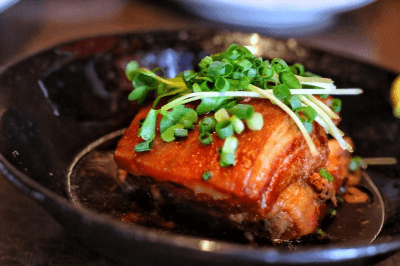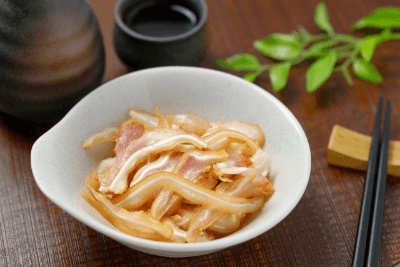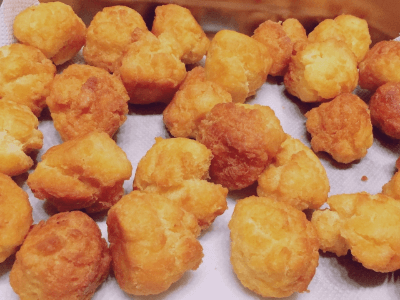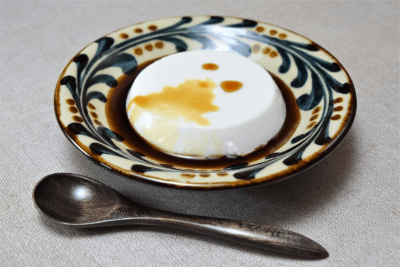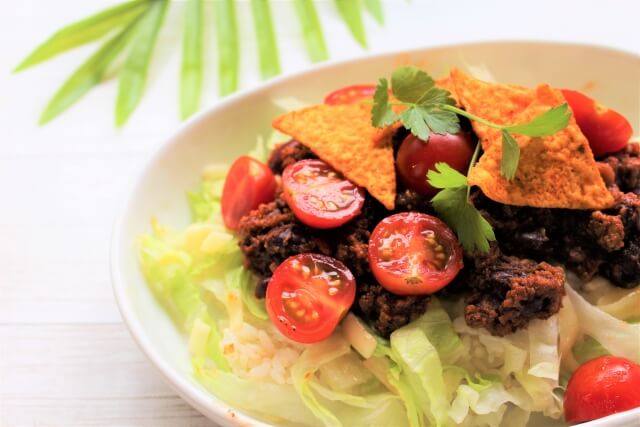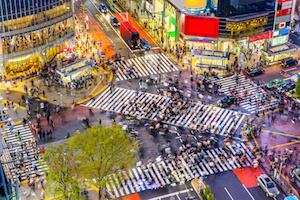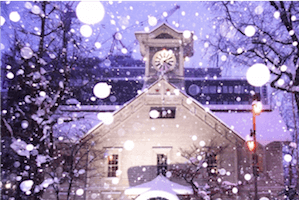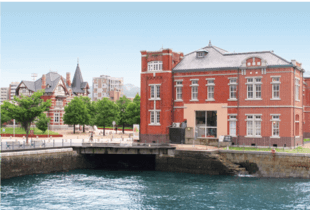-

Okinawa Churaumi Aquarium
The Okinawa Churaumi Aquarium is one the largest aquariums in the world. Its main attraction, the Kuroshio Sea tank, houses 70 species of sea life.
-

Okinawa Kokusaidori
In the heart of Naha, Okinawa's capital, lies Okinawa Kokusaidori. Its name translate to "international road," and it is a lively strip of restaurants, shops, and hotels popular among tourists and locals alike.
-

Makishi Public Market
Another popular tourist attraction in Naha is the Makishi Public Market, where a variety of unique Okinawan ingredients, groceries, cooked dishes, and desserts are available. It is currently undergoing renovations but has a temporary home nearby until its reopening in March 2022.
-

Okinawa World
This theme park is intended to give tourists a taste of historical Okinawan culture and tradition. It features an impressive limestone cave you can walk through, a replica of a traditional Ryukyu village, and a snake museum based around the habu – a local, highly venomous snake.
-

Valley of Gangala
A bus ride from Naha lies the grandiose limestone Gangala Cave. Guided tours are available so you can learn about the history and significance this cave from prehistoric times to WWII and beyond.
-

Kaichu Road
Drive along Kaichu Road and experience the sensation of gliding across the sea. This road bridge stretches between Okinawa and Henza Island, and provides beautiful panoramic ocean views.
-

Yachimun no Sato
Yachimun no Sato, or the Yomitan Pottery Village, is a peaceful area to wander about north of Naha. Small pottery shops, kilns, studios, and houses make up this small artistic community. Today, there are about 45 potters and glass artists who work in this district.
-

Zakimi Castle Ruins
Go back in history and explore these Ryukyuan fortress ruins in central Okinawa. It's high elevations grants visitors stunning panoramic views of the island, especially at sunset.
-

Katsuren Castle Ruins
Another former Ryukyuan fortress is Katsuren Castle. Today, you can visit its ruins and enjoy its unique architecture that integrates with the natural land formations it was built upon.
-

Blue Cave Okinawa
If you're interested in snorkeling or scuba diving, don't pass up on Blue Cave. The water glows a distinct bright blue color in this cave shaped by the sea over time. Since the sea life is accustomed to human visitors, you'll be able to see and swim with many fish!
-

Naminoue Shrine
Naminoue Shrine is a Shinto shrine located in Naha. It has been (and continues to be) one of the most culturally significant shrines in Japan, with its origins dating back to Ryukyu Kingdom times.
-

Shisa
Shisa are beasts from Okinawan mythology that are seen as wards and used as protection charms. You'll often see pairs of these lion-dog figures on roofs and gates of Okinawan homes. You can buy your own shisa duo to bring home with you from Okinawa, selecting from a wide array of colors, sizes, and both traditional and contemporary designs.
-

Ryukyu Glass
The art of Ryukyu glass is distinct to Okinawa, arising in the period after WWII. During the period of hardship following the war, Okinawan glass artists repurposed Coke bottles and other glass scraps discarded by Americans stationed on the island to create practical, but unique, glassware. What started as a survival tactic has become a source of artistic and cultural pride and tradition.
-

Bingata
Bingata is a traditional dying technique that is unique to Okinawa, developed during the Ryukyu Kingdom period. It features very vibrant colors and is thought to synthesize Indian, Chinese, and Javenese dying processes. Today, you can buy your own bingata cloth as a souvineer or even take a class and make your own in Okinawa.
-

Chinsuko
With a taste and texture similar to shortbread, chinsuko is a traditional Okinawan sweet that makes a delicious souvenir.
-

Beniimo Tart
The beniimo, a deep purple sweet potato, is considered one of Okinawa's local specialties and is enjoyed in a variety of ways. The beniimo tart, however, might be the most famous and is a popular souvenir to take home and share with friends.
-

Umibudo (Sea Grapes)
Umibudo are a popular side dish and snack in Okinawa, often enjoyed with soy sauce alongside a beer. It's a type of seaweed with bubbles of air, in place of leaves, on its stem that explains its namesake. The refreshing "popping" sensation umibudo confers when eaten is unique and sought-after, called "puchi-puchi" in Japanese.
-

Yachimun
In Okinawan dialect, "yachimun" translates to "pottery". The potters of Okinawa developed a unique style over time, distinguished by the pottery's warm colors and rustic feel. Though you can find yachimun pottery for sale throughout Okinawa, you can also visit Yachimun no Sato (Yachimun Pottery Village), where a community of around 45 Okinawan potters and artists work today.
-

Jimami Tofu
While ordinary tofu is made from soybeans, this Okinawan spin on tofu is made from peanuts and potato starch. Jimami tofu can be enjoyed both as a sweet and savory dish, and makes an excellent souvenir to share the unique flavors of Okinawa with friends.
-

Shima Togarashi
Shima togarashi is a small, red, and very hot chili pepper of Okinawa. It is processed into a dry pepper powder called Yanbaru Hiri Hiri, of which a little goes a long way.
-

Yonaha Maehama Beach
Miyako, a small island in Okinawa Prefecture, is home to this small but beautiful beach. Yonaha Maehama Beach has a good balance of coral and fish for the exploratory swimmer or snorkeler.
-

Minna Island Beach
Minna Island is a small, isolated island in Okinawa surrounded by a coral reef that is known its ocean recreational activities. Visitors flock here to swim, dive, snorkel, and go boating.
-

Kondoi Beach
This tranquil beach on Taketomi Island features a sandy beach and shallow waters that make it ideal for those with children.
-

Sesoko Beach
Sesoko Beach lies on Sesoko Island, which is accessible from Okinawa's main island by car. An expansive stretch of white sandy beach awaits you here!
-

Kouri Beach
Now accessible by car, Kouri Beach is a favorite of locals and visitors alike. Enjoy a white sand, clean turquoise water, and views of the Kouri Bridge from this beach. At night, you'll have a great view of the stars!
-

Kozamami Beach
On Zamami Island lies Kozamami Beach – also called Old Zamami Beach. It is an excellent spot for swimming and snorkeling.
-

Toyosaki Chura Sun Beach
Located just 20 minutes from Naha Airport, Toyosaki Chura Sun Beach is a convenient and popular beach on the Okinawa main island. It is the largest artificial beach in Okinawa, and the perfect place to catch a beautiful sunset!
-

Hatenohama Beach
Hatenohama Beach refers to a 7km-long uninhabited island near Kumejima Island in Okinawa. It consists of three sandbars of sandy, white beaches. There are a variety of tour services through which you can visit this beautiful, unmarred stretch of beach.
-

Sunayama Beach
This is a popular beach on Miyako Island. After a short walk through wild vegetation, you'll find yourself on a beach shaped by tides and winds over time. A picturesque arch, diverse coral, and beautiful blue waters lie at Sunayama Beach!
-

Nishihama Beach
Though a little harder (and more expensive) to access than other beaches in Okinawa, Nishihama Beach is consistently rated as one of the area's best beaches. Its seclusion and excellent snorkeling conditions help it stand out from the rest.
-

Aharen Beach
Aharen Beach is a popular beach on Tokashiki Island, welcoming visitors with translucent blue waters and coral reefs that make it ideal for snorkeling.
-

Ishigaki Island
One of the more popular remote islands in Okinawa is Ishigaki Island. One of the most southernmost islands of Japan, it features beautiful beaches, hiking, and night skies – it's one of the best islands in Japan for stargazing. Its remoteness has also lent itself to the development of a unique island culture with specialty foods, song, and dance.
-

Ie Island
Ie Island, a 30-minute ferry ride from Mobotu Port in northern Okinawa, is perhaps best known for the distinct mountain the rises from the otherwise relatively flat small island. A hike to the top of Mount Gusuku, also called Tacchu, is rewarded with a 360 degree view of the island, Okinawa, and the surrounding blue sea. The island is also known for its beautiful flowers, with its annual Lily Festival attracting tourists every April. Local specialties include sugar, peanuts, and beef.
-

Hateruma Island
The southernmost inhabited island of Japan is Hateruma Island, accessible by ferry from Ishigaki island. Snorkeling-friendly beaches, sprawling sugarcane plantations, and unparalleled stargazing await visitors here.
-

Tonaki Island
Retreat to Tonaki Island, where rustic Japanese architecture and community traditions persevere. About 400 people live on this tiny island known for its warmth and welcoming atmosphere. With the town of Tonaki being designated as an Important Preservation District for Groups of Historic Buildings, you'll have the sense of stepping back in time when you visit this island.
-

Kohama Island
This small remote island was the setting of the NHK drama Churasan, which cast the national spotlight on Kohama Island and attracts many Japanese tourists. On the island, visitors can enjoy a hike up Ufudake mountain, views of sweeping sugar plantations along "Sugar Road", and beautiful beaches (of course).
-

Iheya Island
Natural landscapes and formations are preserved on Kohama Island, which has some of the most pristine and translucent waters in Okinawa – fishing is big here! The remote island has a long and lasting tradition of pre-Buddhist, animist ritual that has undoubtedly influenced the community's reverence for nature. A popular site to visit is Kumaya Cave, an ancient place of worship that requires squeezing through a narrow crag to enter.
-

Minna Island
Easily accessible from Okinawa Island, Minna Island is a popular destination for those interested in water recreational activities – such as swimming, snorkeling, and diving! If you stay the night on a clear day, you'll catch a beautiful sunset along the beach. The island is home to only about 40 people, though it draws tens of thousands of tourists each year.
-

Kudaka Island
Only a 15 minute ferry ride from Okinawa Island, Kudaka Island is a terrific day-trip spot! The island is considered one of the holiest sites in Okinawa. According to Ryukyu legend, it was the first island descended upon and created by creator goddess Amamikiyo. A strong sense of ritualistic tradition perseveres today, and there are various sacred sites (utaki) you can visit on the island. Sea snake soup is a local delicacy of the island as well!
-

Kouri Island
Drive over the Kouri Bridge to access Kouri Island, a tiny island famous for its sandy beaches with turquoise waters. If you're seeking magnificent views, head to the observation deck at Kouri Ocean Tower.
-

Miyako Island
Miyako Island is the fourth largest island in Okinawa Prefecture, best known for its white sandy beaches and beautiful scenery. Surrounding coral reefs provide excellent snorkeling conditions. Other popular tourist destination spots include the Eastern Cape, the Tropical Botanical Bridges, and the bridges that connect Miyako to smaller neighboring islands.
-

Hamahiga Island
Accessible by car, Hamahiga island is a small island with great spiritual significance in Okinawa. It is the home of Shirumichu, a sacred cave known as the original dwelling place of Ryukyuan creation gods Amamikiyo and Shinerikiyo. Muruku Beach, the two towns of Hama and Higa, and a salt factory are among the other attractions of the island.
-

Ou Island
A quick drive from the Okinawa mainland, Ou Island offers calm waters that are ideal for scuba diving and many sacred worship sites to explore. In addition, cheap but tasty tempura using the freshest seafood is a popular food to snack on here.
-

Iriomote Island
Though it is the second largest album in Okinawa – second only to the main island – Iriomote Island remains largely undeveloped and and covered in dense jungle. Explore the unique natural landscape yourself with a trip to the vast Iriomote-Ishigaki National Park. Outdoor recreational activities like hiking, kayaking, fishing, sailing, and diving are very popular on this island!


























